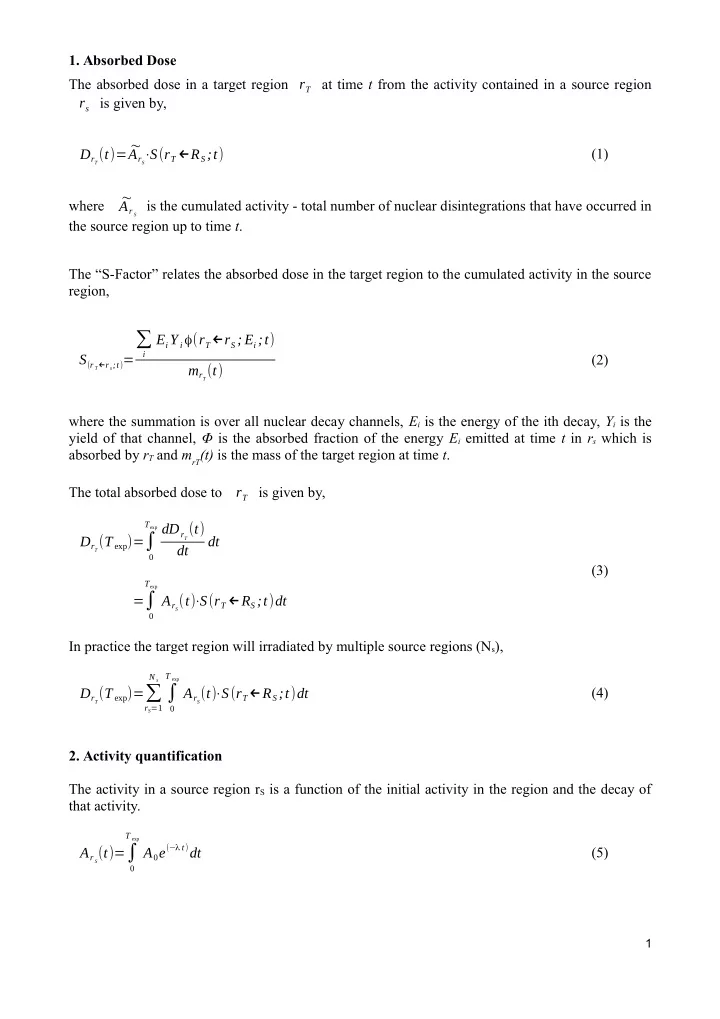

1. Absorbed Dose The absorbed dose in a target region r T at time t from the activity contained in a source region r s is given by, D r T ( t )= ~ A r S ⋅ S ( r T ← R S ;t ) (1) ~ where A r S is the cumulated activity - total number of nuclear disintegrations that have occurred in the source region up to time t . The “S-Factor” relates the absorbed dose in the target region to the cumulated activity in the source region, ∑ E i Y i φ( r T ← r S ; E i ;t ) i S ( r T ← r s ;t ) = (2) m r T ( t ) where the summation is over all nuclear decay channels, E i is the energy of the ith decay, Y i is the yield of that channel, Φ is the absorbed fraction of the energy E i emitted at time t in r s which is absorbed by r T and m rT (t) is the mass of the target region at time t . The total absorbed dose to r T is given by, T exp dD r T ( t ) D r T ( T exp )= ∫ dt dt 0 (3) T exp = ∫ A r S ( t )⋅ S ( r T ← R S ;t ) dt 0 In practice the target region will irradiated by multiple source regions (N s ), T exp N s D r T ( T exp )= ∑ ∫ A r S ( t ) ⋅ S ( r T ← R S ;t ) dt (4) r S = 1 0 2. Activity quantification The activity in a source region r S is a function of the initial activity in the region and the decay of that activity. T exp A r S ( t )= ∫ (−λ t ) dt (5) A 0 e 0 1
For MRT the decay constant, λ, has a biological and physical component, T exp A r S ( t )= ∫ (−(λ physical +λ biological ) t ) dt A 0 e (6) 0 The initial activity, A 0 , is determined from SPECT imaging using a phantom scan with a known activity as a calibration standard. A 0 = cf ⋅ N γ (7) where the calibration factor, cf, is defined as, Ref cf = A (8) Ref N γ N γ is determined from SPECT projections (EM) which have been scatter corrected (SC). N γ = EM ( r , φ)− SC ( r , φ) (9) Attenuation correction (AC) is also commonly applied. For a non uniform attenuating medium this is an iterative process using OSEM. For uniform attenuation it can be simplified using the Chang technique. EM AC ( r , φ)= EM ( r , φ) (10) M 1 M ∑ −μ l i e i = 1 where M is the total number of projections used to acquire the data and l i is the distance to the object in the ith projection. The reference activity is based on a decay corrected calibrator standard. −Δ t / t ( 1 / 2 ) A Ref = A calibrator ( m 4 − m 3 ) 2 (11) ( m 2 − m 1 ) And hence, −Δ t / t ( 1 / 2 ) A 0 = A calibrator ( m 4 − m 3 ) 2 ⋅ EM ( r , φ) − SC ( r , φ) (12) EM Ref ( r , φ) − SC Ref ( r , φ) M M 1 1 M ∑ M ∑ −μ EM l i −μ SC l i e e M M 1 1 M ∑ M ∑ −μ EM l i −μ SC l i i = 1 i = 1 e e i = 1 i = 1 2
3. Expression for total absorbed dose T exp N s D r T ( T exp )= ∑ ∫ (−(λ physical +λ biological ) t ) ⋅ S ( r T ← R S ;t ) dt (13) A 0 e r S = 1 0 T exp N s D r T ( T exp )= cf ⋅( EM AC ( r , φ)− SC AC ( r , φ)) ∑ ∫ (−(λ physical +λ biological ) t ) ⋅ S ( r T ← R S ;t ) dt (14) e r S = 1 0 T exp N s D r T ( T exp )= cf ⋅( EM AC ( r , φ)− SC AC ( r , φ)) ∑ ∫ (−(λ physical +λ biological ) t ) ⋅ S ( r T ← R S ;t ) dt (15) e r S = 1 0 We can split this into four main components which effect dose (highlighted in colour here). ∑ E i Y i φ( r T ← r S ; E i ;t ) T exp N s D r T ( T exp )= cf ⋅( EM AC ( r , φ)− SC AC ( r , φ)) ∑ ∫ (−(λ physical +λ biological ) t ) ⋅ i e dt (16) m r T ( t ) r S = 1 0 The key parts of each expression are now highlighted in bold. ∑ E i Y i φ( r T ← r S ;E i ;t ) T exp N s ( EM AC ( r , φ)− SC AC ( r , φ)) ∑ ∫ (−(λ physical + λ biological ) t ) ⋅ i D r T ( T exp )= cf ⋅ e dt (17) m r T ( t ) r S = 1 0 3
Recommend
More recommend